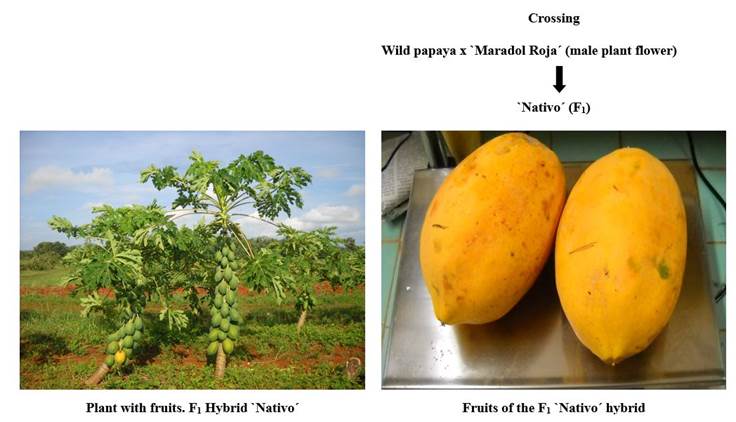Mi SciELO
Servicios Personalizados
Articulo
Indicadores
-
 Citado por SciELO
Citado por SciELO
Links relacionados
-
 Similares en
SciELO
Similares en
SciELO
Compartir
Cultivos Tropicales
versión On-line ISSN 1819-4087
cultrop vol.40 no.3 La Habana jul.-set. 2019 Epub 01-Sep-2019
Report of new cultivar
`Nativo´ cuban papaya hybrid (Carica papaya L.)
1Instituto Nacional de Ciencias Agrícolas (INCA), carretera San José-Tapaste, km 3½, Gaveta Postal 1, San José de las Lajas, Mayabeque, Cuba. CP 32 700
`Nativo´, obtained from the crossing of a wild genotype with `Maradol Roja´. The `hybrid´ has characteristics that allow increasing the diversity of this species in traditional farming systems. In addition, it provides a choice of different fruits in the local market, where there is a predominance of larger fruits. Its physiological and agronomic response was in different locations in the basin validated, where it was for its high agricultural yield (80.1 t ha-1) noted under low input conditions.
Key words: breeding; crossing; cultivar; yield
INTRODUCTION
In Cuba, papaya has been cultivated on a commercial scale since 1906. However, the predominance of `Maradol Roja´ in the main areas destined to plant this fruit in the country, contributed to the reduction of the genetic diversity of the species in Traditional farming systems. In this work, the characteristics of a new papaya hybrid cultivar, obtained at the National Institute of Agricultural Sciences (INCA), are reported by crossing a wild variety prospected and characterized in the Almendares-Vento basin with `Maradol Roja´. The new 'hybrid' has characteristics that allow increasing the diversity of this species in traditional farming systems. It also provides a choice of different fruits in the local market, where there is a predominance of fruits of greater dimensions, which in turn leads to greater diversification of production.
Origin
The hybrid (F1) `Nativo´ was obtained in 2010, from the crossing of the wild papaya genotype (Carica cubensis Solms), prospected and characterized in the Almendares-Vento basin, with pollen from flowers of `Maradol Roja´ male plants (Figure 1), also of Cuban origin and of greater importance in the country. F1 seeds and their parents were sown in different environments at the local level in the basin, along with their parents, in order to assess their physiological and agronomic response, referring to the quality of the fruit and its degree of heterosis, with respect to yield . The hybrid stood out for its agricultural yield (80.1 t ha-1) under conditions of low inputs and fruit quality, in line with cultivars of high demand in the international market. In addition, to obtain new F1 hybrid seeds that were sown the following years.
Morphological characteristics of the plant
Plant height: 276 cm
Height of the first fruit: 63.9 cm
Stem diameter: 12.3 cm
Number of leaves in pre-harvest: 33.5
Petiole diameter: 2.64 cm
Petiole length: 87.7 cm
Length of the blade. 46.5 cm
Leaf blade width: 73.1 cm
Limbo Color: Green
Petiole color: Green with medium presence of anthocyanin pigments
Fruit characteristics
Equatorial diameter of the fruit: 11.6 cm
Polar diameter of the fruit: 17.6 cm
Fruit mesocarp thickness: 3.3 cm
Average fruit mass: 0.859 kg
Fruit Shape: Ellipsoid Oblong
Shape of the central fruit cavity: Starred and semi-starred
Fruit Crust Color: Orange Yellow
Pulp Color: Orange
Fruit ºBrix: 11.69
Received: June 04, 2018; Accepted: August 30, 2019











 texto en
texto en 



